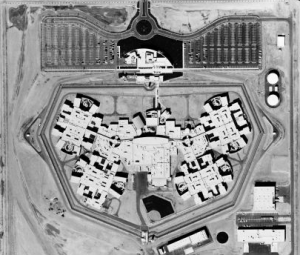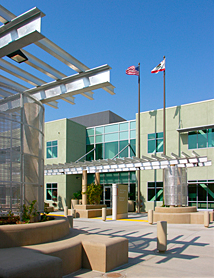Coalinga State Hospital

Coalinga State Hospital (f. Sep, 2005) is a 1500-bed state mental hospital near Coalinga, California, operated by the California Department of Mental Health (DMH) and used by the American state to imprison "Sexually Violent Predators" after they have served their prison sentences. This controversial practise, known as "civil commitment", takes advantage of mental health diagnostics to enforce what are probably unconstitutional, extended prison sentences. The term "Sexually Violent Predator", criticised later in this article, includes those convicted of crimes including the mild fondling of younger minors.
The hospital, located hours away from any major city in California and almost adjoined to Pleasant Valley State Prison, is used to incarcerate a small number of diagnosed, mentally ill offenders from the California Department of Corrections and Rehabilitation (CDCR), with a much larger number of patients made up of men committed under the sexually violent predator (SVP) laws - first Megan's Law and later Jessica's Law. The latter group are deemed too likely to reoffend to be released and are imprisoned indefinitely at the hospital until they engage in and complete rigorous sex offender treatment and agree to rigid conditional parole requirements.
Coercive treatment
The hospital uses an "optional", five-phase treatment program for "SVPs", developed when such individuals were still mostly all treated at Atascadero State Hospital. The program, which if completed, may lead to the release of committed individuals is intensive, incredibly hard to pass and requires admission of guilt. Inmates have observed that mental health professionals within the facility, and indeed any authority that receives funding to maintain it, have a vested interest in failing and retaining committed individuals, who have no idea of when (if at all) they will be allowed to leave. In this sense, the "hospital" could be said to function as a microcosm of the prison industrial complex.
The California Department of Mental Health (DMH) has admitted they screen out the more aggressive candidates because they are too much trouble. Joe Power alleges that this revelation "could lead inmates to conclude that if you ever find yourself facing civil commitment, be aggressive, be violent, join a gang – do whatever you need to do to make yourself too bitter a pill to swallow".
Protests
As of 2008, as much as 75% of the population remains on strike, refusing to cooperate with the "impulse control" treatment program. A number of the inmates participated in a hunger strike, to call attention to conditions at the unit. The strike came to public attention through a press release issued jointly by detainees and the support group Friends and Families of California Detainees. It was also highlighted in an evening news broadcast from Pacifica Radio station KPFA on August 24, 2007. Inmates and sex offender activism critics have charged that the controversial SVP program, instituted in 1998, is based on public fear instead of science, and that the hospital functions essentially as ex post facto imprisonment, or an unconstitutional extension of detainees’ prison sentences imposed after their time has been served.
In the KPFA report, Allan Marshall, director of Friends and Families of California Detainees, explained:
- “The term ‘sexually violent predator’ has unfortunately come into some popularity in this country and has come to mean something quite different from what any reasonable person would expect sexually violent would mean. Factors such as the age of the victim, the number of the victims and whether they are related or not. Those are factors which they take into consideration in calling someone sexually violent -- not at all what we would typically think of [as] violent. So they have sort of redefined terms which I believe is a means to inflame public opinion, and I think that has resulted in very Draconian, citizen based demand for further punishment of sex offenders.”
In their press release, Coalinga detainees charge the hospital administration with a wide range of abuses and raise the concern that the opacity of the system may also hide extensive corruption. Inmates claim they are subjected to extremely restrictive and arbitrary rules and procedures, poorly cared for by insufficient medical staff, inadequately fed and not allowed to see beyond the hospital walls.
A particular point of concern is the coercive program of collective interrogation and conditioning, passed off by administrators as “treatment.” A premise of psychiatric practice is that a patient must be willingly engaged in a therapeutic project – a prerequisite which the SVP program fails to meet by its very nature. Inmates have expressed concern that this program, rather than being therapeutic or rehabilitative, is actually designed to collect information and facilitate biased staff “evaluations” slanted to keep them confined forever. Critics are also concerned that the commitments may not be based upon an inmate’s actions so much as his expressed beliefs.
At the same time, the periodic assessments that are supposed to be performed to determine whether an inmate is eligible for confinement seem to be missing in action: “Our number one issue is the assessments which they have never done on any of us. I’ve been here at this hospital for eleven months and I’ve never seen a psychiatrist. They’ve never done an evaluation to determine where I’m at or what I need for treatment or what’s necessary for me to be released or any of that stuff” says inmate Michael St. Martin in the KPFA report.
Organised protest
A protest outside of CSH was cosponsored by Friends and Family of California Civil Detainees (detainees@gmail.com) and the group Reform of Sex Offender Laws (http://www.rsol.org). Also participating were Tom Madison, President of S.O.Clear, Jeff Griffen of the “Citizens Committee on Human Rights”, Starchild (unfortunately a Scientologist) and several others.
Bad staffing

The DMH has had difficulty staffing the program. High staff turnover rates and a dearth of licensed psychologists and medical staff have been cited by the detainees as ongoing issues at the facility. According to St. Martin, “they don’t have any staff here. They had 11 psychologists. They’re now down to 8 psychologists because three just left. Of those 8 psychologists, only four of them are licensed so they only have 4 licensed clinicians. They have 3 psychiatrists here at the hospital for about 700 people and those psychiatrists have been brought in from India. The second thing is that we have this huge, huge deficit of doctors here -- medical doctors.”
The hospital’s founding director, Walter Thomas Voss, had no credentials in the fields of psychology, psychiatry or medicine. According to the press release announcing his appointment in 2002, Voss was a Navy veteran with a BA degree from the University of Phoenix and 25 years of experience as an administrator of medical facilities within the California Department of Corrections -- facilities which have received extensive press coverage for their shockingly inadequate standard of care. Voss has since resigned and his replacement has also resigned.
TV coverage
The hospital formed the basis of a 2009 Louis Theroux BBC television documentary entitled A Place for Paedophiles, which largely ignored the majority of inmates who rejected treatment.
Commentary
Joe Power - Walking the Line (again)
- "Coalinga State Hospital (hereafter, CSH) is an incredible boondoggle. Costing over $388 Million to construct, the 1,500-bed facility is the largest sex offender civil commitment lockup in the US. Currently about 700 men are held there. Thanks to the voter approved (yet now increasingly regretted) Proposition 73, most of these men will be there until they die.
- In keeping with California’s current practice of building prisons in the remotest areas possible, CSH is out in the middle of nowhere, its nearest big neighbor a giant commercial cattle farm (which regularly graces the ‘hospital’ with a malodorous stench.)
- On its website, the department responsible for CSH claims that it is a state-of-the-art mental hospital. This is a lie. It is staffed heavily by prison guards because the state can’t find enough “therapists” who want to work there even at more than twice the pay of equivalent workers at other state hospitals. (The few staff psychiatrists working at CSH were brought over from India, because the state couldn’t find any American doctors willing to take these positions.)
- The so-called “hospital” serves prison food (which is neither terribly tasty nor healthy, but the state has a nearly $20 Billion dollar budget shortfall so I guess they’re lucky to eat at all!)
- The inmates (we refuse to call them patients) are subjected to arbitrary and capricious rules – often worse than regular prison rules – regarding possessions, activities, etc. In fact, inmates who refuse to participate in the ‘treatment’ program (the vast majority, by the way) are illegally denied exercise and other opportunities.
- Currently, I know of three men in CSH. All three have served the long sentences they received for non-violent offenses. All three have spent years awaiting their first (and now, effectively, their only) civil commitment hearing, longer than they would have been on parole.
- I am in regular contact with one of these men. He has chosen to actively resist the banal evil of the place. He reports frequently of a revolving door at the top of the administration (it isn’t just low level folks the state can’t keep) which causes low staff morale and institutional gridlock preventing any and all promised improvements (how convenient!) He tells of utterly dispirited men who have come to realize they are no longer seen as human beings with human rights but simply sources of income for the Dept. of Mental Health and the highly paid evaluators.
- Most of them know the only way they will get out is feet-first (an increasingly common occurrence given the substandard medical treatment they receive at this “state-of-the-art hospital”.) But what disheartens many of them the most is the feeling they have been totally abandoned and forgotten – that no one on the outside knows or cares that they are in there."
External links
- Official site
- Sexgulag.org - Opposition group
- Voices of the Gulag - Opposition group
- Prison scandal at Coalinga - Used as a source